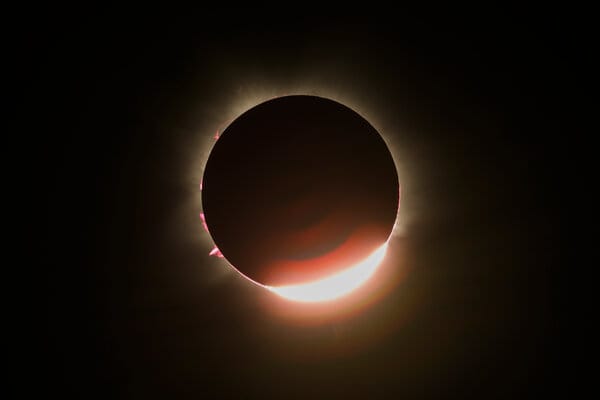
As North America prepares for its second total solar eclipse in seven years on April 8, the Moon will cast a shadow over a portion of the Earth, shrouding it in darkness. The astronomical spectacle will begin on the Mexican mainland and end in Canada. As the Moon passes between the Earth and the Sun, it will obscure the solar light and prevent us from seeing it directly.
The once-in-a-blue-moon alignment causes the two bodies to appear similarly sized in the sky. The total eclipse begins with a partial eclipse and lasts until the Moon completely covers the Sun. According to NASA, this phenomenon lasts approximately 70 to 80 minutes. Totality occurs when the Moon completely blocks the Sun.
Interesting facts about the total solar eclipse
1. Earth is the only planet that experiences a perfect total solar eclipse
Because of the Sun and Moon’s relative size and distance from the planet, Earth is the only planet in our solar system that experiences a perfect total solar eclipse. No other planet’s Moon is of comparable size to enable the phenomenon.
2. About 600 million years from now, Earth will experience a total solar eclipse for the last time
Richard Vondrak, a lunar scientist at NASA’s Goddard Space Flight Centre, previously described a total eclipse as “a dance with three partners: the moon, the sun, and Earth.” He went on to say, “About 600 million years from now, Earth will experience the beauty and drama of a total solar eclipse for the last time.”
Total solar eclipses occur due to the relative sizes and distances between the Moon and the Sun. While the Sun is about 400 times wider than the Moon, the latter is about 400 times closer to the Earth; both bodies appear to be the same size in Earth’s sky. However, a NASA statement addressed the increasing distance between the Moon and Earth – about 1.5 inches per year – which affects the resulting total solar eclipse due to the Moon’s reduced size in the sky. As a result, “over time, the number and frequency of total solar eclipses will decrease.”
3. Nazas, Mexico, will have the longest eclipse on April 8th
Nazas, Mexico, will have the longest eclipse duration on April 8, with 4 minutes and 28 seconds of totality. This will be longer than Rapa Nui’s total eclipse of 4 minutes and 40 seconds in July 2010. The 2027 total solar eclipse is expected to last 6 minutes and 23 seconds in Egypt.
4. Saros cycle: The Sun, Moon, and Earth align to produce a similar solar eclipse after 18 years, 11 days, and eight hours
Every 18 years, 11 days, and eight hours, the Sun, Moon, and Earth align to produce a similar solar eclipse. The April 8, 2024 alignment will follow the same pattern on April 20, 2042.
5. The next total solar eclipse in North America will take place on August 23, 2044
The last total solar eclipse in North America took place on August 21, 2017. Seven years ago, it traveled from Oregon to South Carolina. The next one will take place 20 years later, on August 23, 2044.
6. Not every “New Moon” results in a solar eclipse.
A solar eclipse can only occur during one lunar phase: the New Moon. However, not every New Moon results in a solar eclipse.
7. The Sun’s corona can be viewed only during a total solar eclipse
The Sun’s corona, or the outermost part of its atmosphere, can only be seen during a total solar eclipse. The naked eye cannot see the corona because it is obscured by the Sun’s bright light. During a total solar eclipse, the Moon blocks the Sun’s ferocious brightness, allowing the corona’s white light to be visible as the Moon appears as a black disk over the Sun.
8. Solar eclipse results in two parts of the Moon’s shadow
A solar eclipse divides the Moon’s shadow into two parts: the umbra (darker inner shadow) and the penumbra (fainter outer shadow). The umbra completely blocks the Sun’s light, so observers must be within this phase of the shadow to see a total solar eclipse. A partial eclipse will be visible to those in the penumbra; no eclipse will occur outside of the Moon’s shadow.
9. An annular solar eclipse doesn’t fully cover the Sun’s disk
Unlike a total solar eclipse, an annular solar eclipse does not completely cover the Sun’s disk. When this happens, the Sun’s outer edge appears as a “annulus” or bright ring, also known as the “Ring of Fire” effect. The Moon’s distance from the Earth varies depending on its location because its orbit is elliptical rather than a perfect circle. Apogee is the farthest point from Earth in the orbit, and the Moon appears smaller. The annular solar eclipse occurs when the Moon covers the Sun at or near its apogee.
